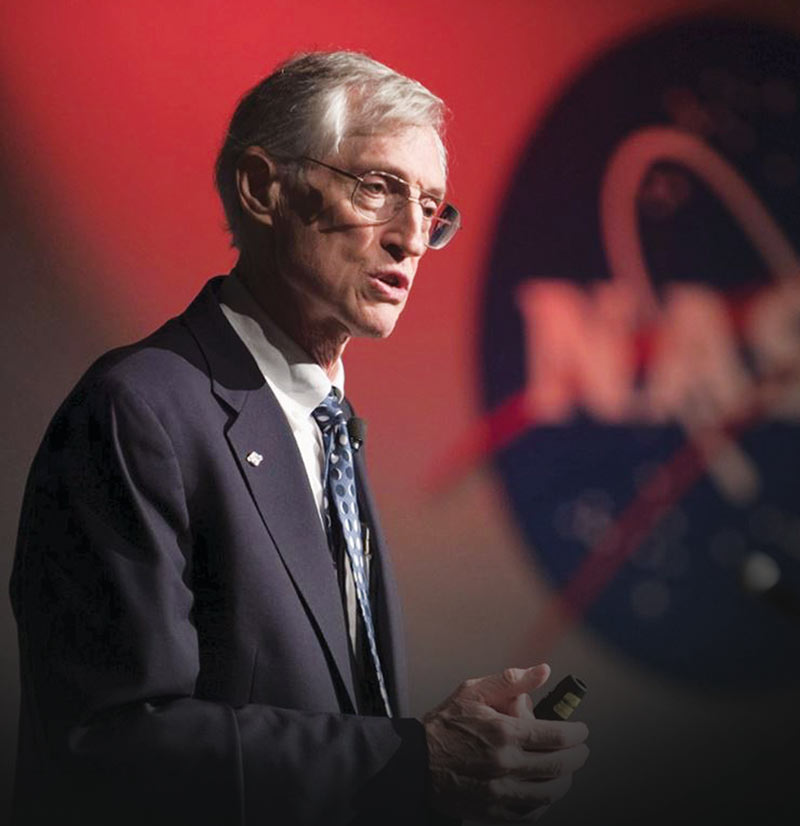A Nobelist’s Next Move John Mather
Winter
2019
Feature
A Nobelist’s Next Move John Mather
Rachel Kaufman, Editor
And he’s going to do it again, looking back to within 200 million years of the big bang as the senior project scientist for the James Webb Space Telescope (JWST).
“We’re looking for those rare things that are at the earliest times in the universe—that’s something that I’m really excited about,” he told Space.com in a 2011 interview. Mather will bring the excitement of JWST and its potential to answer unanswered questions to PhysCon as a plenary speaker.
Born in Roanoke, Virginia, in 1946 and raised in New Jersey, Mather grew up interested in math and science. He wrote in 2006 that his earliest school memory, from age 6, was “realizing that one could fill an entire page with digits and never come to the largest possible number, so I saw what was meant by infinity.” A voracious reader, he hid books under his desk and read rather than pay attention to lessons.
By fourth grade, given a radio kit for Christmas, he quickly was entranced and saved his allowance for a better one to listen to broadcasts from around the world.
He majored in physics as an undergraduate at Swarthmore and moved to Berkeley for graduate research. There, he worked on a project to measure the cosmic microwave background (CMB). Arno Penzias and Robert Wilson had discovered the CMB in 1964 when their new radio telescope picked up a low but steady signal, even after they had eliminated every imaginable source of interference (including pigeon droppings in the antenna). The cosmic microwave background is the earliest electromagnetic radiation in the universe, and its structure is some of the best evidence we have for the big bang.
“I started right in,” Mather wrote. The project was to build a far-infrared spectrometer that would be taken to a mountain in California and pointed at the sky. The spectrometer yielded some “interesting” data, so the next step was to attach a spectrometer to a balloon that would raise it above the Earth’s atmosphere to get a better picture of the CMB. This half of the project did not go quite as well. As Mather recalled:
I’m afraid that my skill was stronger in understanding than it was in implementation, and it’s a true story that the antenna on the balloon payload fell off while it was on the launch pad. It was my solder joint that failed. Fortunately, this fault was noticed, and the payload was launched successfully.
However, it also was true that we had gotten tired of testing, and our instrument did not work, for three different reasons. It was an awful feeling—one that stayed with me for the rest of my life.
Luckily Mather was still able to finish his thesis, writing about the ground-based observations and the design for the balloon instrument. After graduating, he went on to new adventures—but quickly turned back to the cosmic microwave background and began working on what would become COBE. In 1989, the instrument was launched; in 1992, the spacecraft’s measurements of the “wrinkles” in the CMB made the front page of the New York Times. In 2006, he and collaborator George Smoot were awarded a Nobel Prize for their work.
Mather says JWST is now his “major passion.” James Webb, scheduled to launch in 2021, represents “the hopes and ambitions of the 10,000 astronomers who have already used the Hubble,” he told Space.com in 2011. Immensely more powerful than Hubble, JWST will be able to see further back in time to see the earliest galaxies in the universe. “I’m pretty confident there will be surprises out there,” he said, “things that will be worth all this work.”

